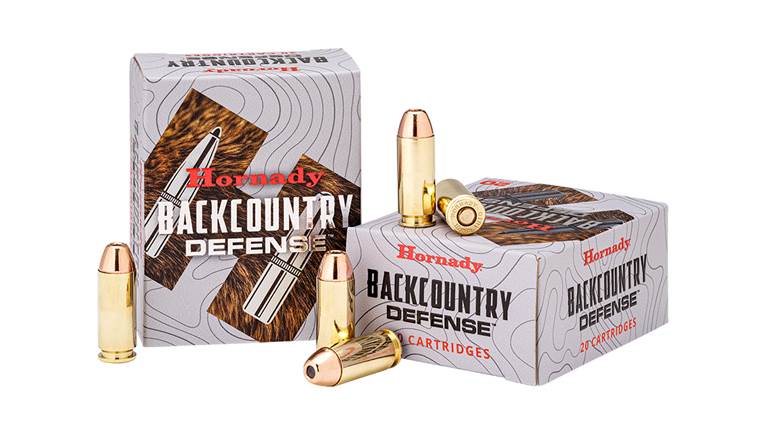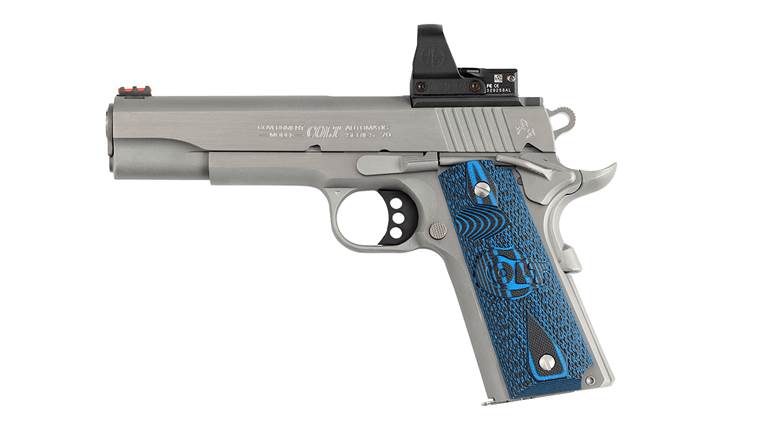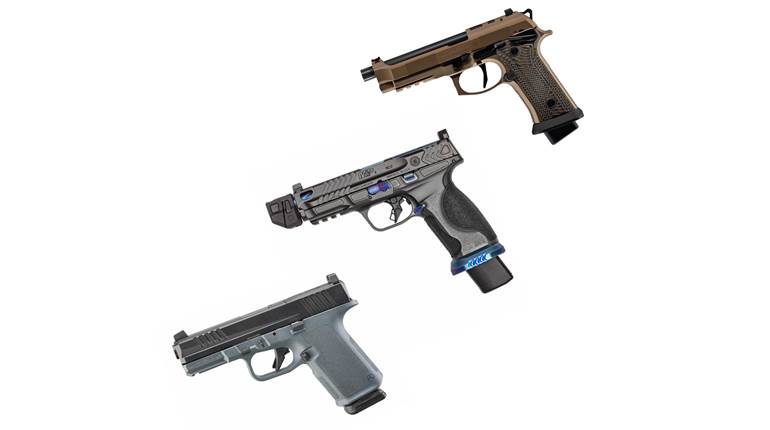
I was extremely fortunate to fall in with a great mentor when the time came to diversify my meager gun collection. More than twice my age, he’d been working on his own collection since boyhood, a lifetime stalking gun-show aisles, browsing area shops and seeking out the Bannerman’s catalog or surplus ads in each new edition of The American Rifleman and Shooter’s Bible.
While it would be wrong to pigeonhole the man’s taste to any specific type or brand, he clearly liked Colt handguns, especially big old Single Action Army and Navy revolvers. I think he was disappointed I never paid them much attention, but nonetheless was a great help when I developed an interest in a couple of Colt semi-automatic pistols. One summer, we searched local gun shows for a Woodsman, the stylish, long-running .22, before it became apparent that that classic model was impractical and too expensive for my ambition of joining an indoor bullseye league. So, to ensure that I didn’t come away empty-handed, he helped me acquire a surplus M1911A1 in NRA Pretty Good condition.
Writing this review of Colt’s new King Cobra (yes, you’ve heard that name before and we’ll get to that directly), I’ve been thinking quite a lot about that gentleman who was a true “influencer” long before Twitter or Instagram came to be, wondering what he’d have to say about a medium-frame, stainless steel .357 Mag. revolver markedly different than his favorites, but whose fluted, six-shot cylinder still rotates clockwise, the way God and Sam Colt intended in making us equals.
Let’s not assume my mentor would be impressed. When it came to newly manufactured guns, he was given to old-man scoffing about how “they don’t make ’em like they used to.” Before even considering feel or performance, he would carefully inspect fit and finish, and if any tooling marks were visible, he’d find them. One time he couldn’t do so occurred in the ’90s when I showed him a Colt Anaconda clad from butt to muzzle in Realtree camouflage, at that time a heavy, vinyl-like transfer film that had all the swank of plastic seat covers in Grandma’s living room. The big .44’s look was so disturbing he immediately went and fetched a blued, walnut-stocked Trooper to remind me what a “real” magnum revolver ought to look like.
His discriminating eye notwithstanding, I’d invite him to find a flaw in the sample King Cobras I’ve been shooting, primarily a 3"-barrel model introduced early last year, plus recent follow-ups, a 2" snubbie called the Carry and the King Cobra Target, fitted with a 4¼" barrel and an adjustable rear sight. All three stand up to my scrutiny with machining as precise and spotless as any I’ve ever seen, and that applies to bore and inner cylinder surfaces, too.

But it wasn’t metalworking artistry that initially sparked my interest. Rather, it was how natural it felt shooting the new King Cobra right from the start, plus the results of those shots—a clean sweep of a plate rack at 15 yds., not such a feat for a skilled handgunner, but because of a lack of dedication to practice, that’s not me. After that encouraging intro at the 2019 SHOT Show range day, I was motivated to dig deeper.
Colt Turns A New Leaf
The new King Cobra is part of a comeback for Colt’s iconic double-action revolver “Snake Guns” that began three years ago with the reprise of an updated Cobra. In an “American Rifleman Television” interview, Colt marketing VP Paul Spitale discussed the first factory-production Snake Gun since the 1990s (note that Colt’s Custom Shop produced limited runs after that) saying, “Customers were letting us know they wanted Colt double-actions, and both new models have been wildly successful since day one. It only made sense to use our original branding, which holds such a special place in the hearts of handgun enthusiasts.”

As the second of the next-gen Snakes, the Colt King Cobra likewise hatched with improvements, but in many ways remained true to its lineage. The original production from 1986-’92 and 1994-’98, was a mid-size .357 Mag. (Colt’s V-frame) with 2½", 4", 6" or 8" barrels. It came both in blued and stainless finish options, though most versions shared black, finger-grooved, neoprene stocks and solid barrel ribs.
The new King Cobra bears a close resemblance, with the notable exception of its elongated, rectangular trigger guard big enough for former boxers or shooters wearing gloves. The re-issue’s frame is quite stout—“heavy-duty” in company parlance—including a 0.60"-wide topstrap beveled to meet the solid barrel rib, plus a full-length underlug with a cutout for the ejector rod. When at rest, less hammer is exposed than in the earlier design. Overall dimensions of the 3" model are 8"x5"x1.4", and, at 28 ozs., it is one of the lightest in the .357 Mag., six-shot class. The longer Target variant weighs 36 ozs., while the Carry, coming with a bobbed hammer in double-action-only, is a slim 26 ozs.
The shorter variants sport Hogue rubber Overmolded stocks that echo the original’s but lack its embedded gold medallion. Nonetheless, a silver “prancing pony” inset does grace the Match’s custom Altamont wood stocks, the lower portion of which are stippled for grip security. The entire run is rendered in stainless steel with a brushed finish that falls between the matte and bright stainless options on earlier King Cobras. The familiar markings are still there. On the left, however, “KING COBRA” brackets a flared serpent head on the barrel, while the trademark pony prances near the grip cutout. Etched on the barrel’s right side is “COLT’S MFG HARTFORD, CT USA,” plus a QC-code square on the frame’s lower front corner that adds a 21st century touch. As before, the cylinders are fluted.

Fitting of its purpose, the Colt King Cobra Target pairs a notched, adjustable rear sight with a red fiber-optic front, but its littermates are considerably more basic, with a squared 0.195"-wide channel in the topstrap aligning onto a brass front bead. Some may question the accuracy potential, but there’s no doubt about this set-up’s ruggedness and utility. Clearly Colt is prioritizing dependability for users confronting short-range threats, and in use, one’s sole focus goes to the gold bead—an old-school approach to low-light sights that is fast and sure. There are no protruding edges to catch on clothing. The bead is interchangeable via a set screw, and the maker plans to offer options to the current brass fixture (Brownells already has fiber-optic and tritium offerings). To reduce glare, both the topstrap and top rib surface are noticeably duller than the rest of the metalwork.
Also stout is the barrel diameter at 0.702", and its slightly recessed crown is another carryover from the old days. The six-groove rifling matches that of the Cobra’s, a Colt standby, according to Field Editor Wiley Clapp, likewise its 1:14" left-hand twist.
While the biggest upgrade isn’t visible, it will be readily noticed by many shooters. Upon re-entering the Snake Gun business, Colt engineers developed a new mainspring and trigger assembly, the double Linear Leaf, or LL2. It replaces earlier leaf springs most find preferable to the coil springs used in some revolvers by Colt and other makers, which tend to “stack” or increase pressure in the course of a double-action trigger pull. Colt says the LL2 largely prevents that problem and, moreover, it makes the hammer swing more linear—and thereby faster—than was the case in earlier iterations. I didn’t know all that during my first go with the Colt King Cobra, but it was immediately apparent that in double-action mode the 9-lb., 2-oz. pull was smooth and quick. In single-action our test model’s trigger broke consistently at 4 lbs., 1 oz., with no grittiness or take-up.

The ejector rod plunges 3/4" to faithfully clear the empties, but some of my colleagues weren’t so keen on the cylinder latch because it pulls rearward (in Colt fashion), and that can mean shifting one’s firing grip when reloading. Also pointed out to me—I hadn’t noticed at first—is that the trigger return hits a tiny bump about halfway through its release stroke. Semi-automatic shooters used to that sort of tactile cue might mistake it for trigger reset, but in order to reset and fully rotate the cylinder, the stroke must go completely forward.
While my shooting experiences with the various Kings was, on the whole, enjoyable and without issue, I noted that potent .357 Mag. loads, though not unbearable or literally painful, quickly become unpleasant. Shooting more than 15 or 20 rounds translated to diminishing returns in my practice sessions versus the milder 125-gr. loads, which I could shoot in double that number before fatigue set in. Naturally, the heftier King Cobra Target made it easier to cope, but with the shorter Carry and its increased muzzle blast, it was smart to cut off sooner.
Also, the Target model, in general, did not perform as well as anticipated. Not only did its trigger exhibit a bit more pull weight—breaking at 5 lbs. even in single-action mode and 9 lbs., 7 ozs., in double-action—we also experienced a fair bit of shavings that blasted the shooter's hand along with a sandbag rest that received a few tears. And while it shot higher-velocity loads better, the last two rounds fired would not allow the cylinder to rotate. In all fairness, those were handloaded 100-gr. .38 Spl. wadcutters at 987 f.p.s., and it appeared they had a primer-seating issue. Of note, the best three-shot group measured with that load was 0.75", but five-shot groups weren’t so spectacular.
Of course, a saving grace of .357 Mag. guns is that they also digest .38 Spl. ammunition, and so shooters can tailor their power level, for carry and/or for practice, according to what suits best. Take my word that .38 wadcutters are sweet-shooting and mostly accurate in all three King Cobras, and it's much the same shooting the lesser cartridge with top defensive loads.
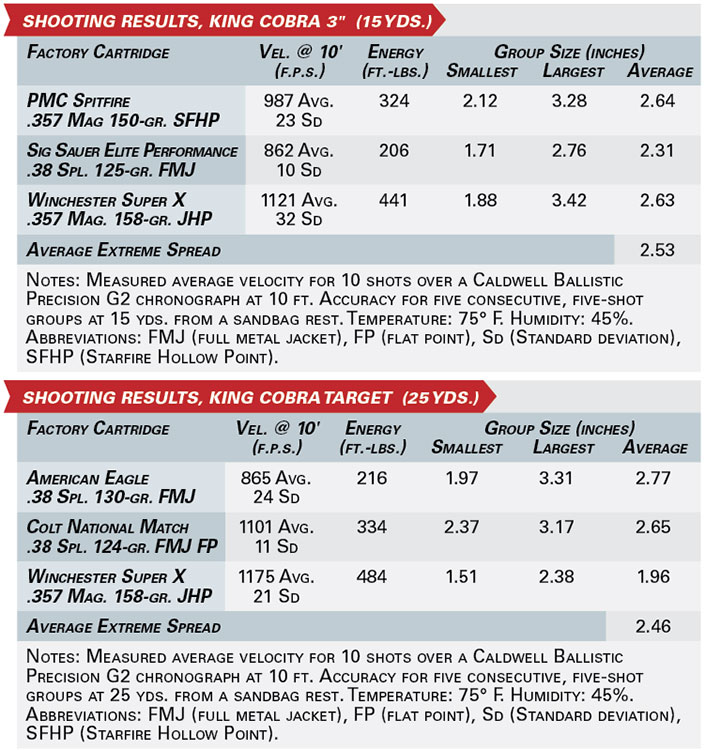
Will The Colt King Cobra Reign Again?
The crux of all this is the question: How well will King Cobras serve personal-protection needs? Only those open to revolvers for carry or home defense will get that far, and then primarily those insisting on .357 Mag. firepower. That’s not a big chunk of today’s market, and not one that’s growing; but it is a stubbornly enduring user group, as evidenced by strong sales, not only for these new entries from Colt, but also for competing models from America’s biggest handgun brand names.
My observation after limited carry is that there’s little difference between the 3" standard and the 2" Carry, a mere 2 ozs. And the former is a more manageable shooter in my book. That said, if one is mostly seeking a pocket pistol, the smaller gun sans hammer spur is the better tool. So judge for yourself: Beyond the myriad more-concealable options with greater magazine capacities, comes this new entry in a marginally larger class that takes a markedly different tactical approach. Viva la difference.
While earlier Cobras and King Cobras weren’t considered particularly high-end, Colt is clearly positioning its new wheelguns for an upscale market, blending technological advances with ruggedness and mostly traditional looks. Given that, it will be interesting to see if the Snake Gun revival extends to some of the more coveted series members. For now though, suffice it to say that the Colt King Cobra is back and offers great versatility in a portable, powerful revolver.

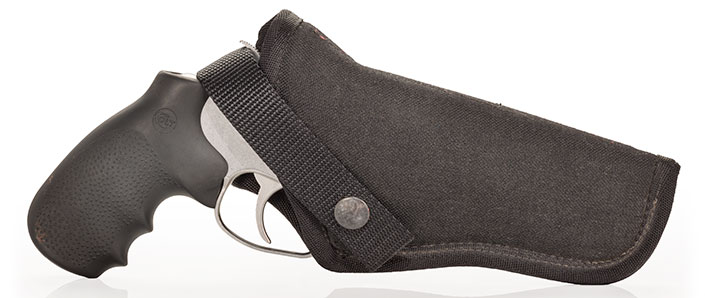
Carrying The Colt King Cobra
Concealed carry was not my only, or even my primary, interest when I took on this project. Along with that pressing consideration, two things appealed to me. First, like my mentor, I’m fascinated by the simple, artful machine that is a revolver. I’m drawn to its appearance, and I appreciate how the mechanics perform the task at hand. A precision-forged, stainless sixgun bearing the historic prancing pony marque could be as close as I get to the riding/shooting lifestyle that was a boyhood ideal.
Though I have an outside-the-waistband Galco concealment holster that works just fine, what I found most practical and gratifying was to carry the King cowboy fashion in an old-style belt holster. The holster I like best is hardly vintage gun leather, but instead a molded nylon number that’s both inexpensive and lightweight, yet fits the new Colts as well can be. (Uncle Mike’s Sidekick line is one place to find these.)

Thus carried, the revolver balances well on my hip, is unobtrusive and its weight barely any burden at all, part of which, I think, is attributable to the wheelgun’s mostly vertical weight distribution. Wearing it while hunting and doing outdoor chores is a snap. It does not impede vehicle entry/egress or sitting on a car seat, chair, stool or on the ground. It’s all but unnoticeable belly-crawling, swinging an axe or carrying water buckets. Yeah, it just feels right. There’s an undeniable peace of mind having such a stand-up tool—a .357 Mag., no less—poised so conveniently for any contingency.
Taking the 3" Colt King Cobra for a hunt in west Texas was rather like taking one’s guitar to Nashville. I split the cylinder between .357 hollow points and the new Browning Trail Force, a combo of No. 9 lead shot with two copper-plated discs, for a tougher-than-status-quo answer to belligerent snakes and varmints.
After that, the trim revolver became a regular piece of my turkey-hunting kit, and for those outings I kept two of the Browning pest loads on deck, backed up with four .38 Spl. FMJs. In that sense, an exposed-hammer revolver can do double-duty, requiring little effort to switch from one type of load to another since you can turn the cylinder without firing by carefully manipulating the hammer and trigger. The same exercise with a semi-automatic would require a magazine change or removing the unwanted rounds by firing or some other means.
Advancing a revolver cylinder may not be any faster than a skilled handgunner can swap out mags, but there’s a lot less movement and invariably it’s quieter. Luckily, I never encountered a threat that caused me to shoot, though I have to admit that after practicing I was very curious as to how those snake-shot cartridges would perform on the real thing.












